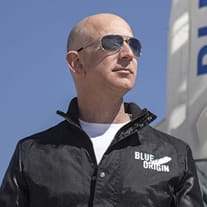The Final Frontier of the Future
It won’t be long before space becomes home to an assortment of commercial, industrial and scientific outposts.
Published October 1, 2018
By Charles Cooper
Academy Contributor

Space may indeed be the final frontier, but it’s also becoming increasingly crowded.
Not today. And perhaps not tomorrow. But it won’t be long before space becomes home to an assortment of commercial, industrial and scientific outposts. In fact, about 900 satellites already circle in low Earth orbit (LEO), most notably the International Space Station (ISS) and the Iridium network of communication satellites. They’re about to have company.
A startup made headlines earlier this year with plans to build a luxury hotel by 2022 that would host 12-day stays in space. Russia’s space agency is reportedly working on a project to add private suites to the ISS, complete with big windows, exercise equipment and, of course, Wi-Fi. Elsewhere, shorter space tourism ventures are being worked on by the likes of Jeff Bezos’ Blue Origin and Virgin Galactic’s suborbital SpaceShip.
But space tourism is just a sideshow to the main event: A future in which humans are able to live safely beyond the Earth for extended, even indefinite, periods of time — and do it sustainably. However, before any of those futuristic scenarios materialize, governments and organizations back on Earth need to come to an agreement on rules to manage the emergence of what will be a complicated ecosystem shared by public and private entities.
Setting Up a Space Traffic Control System

Prior to World War II, the air traffic control system was established to coordinate and track flights. Could something similar work for LEO? In theory, yes, but with a few tweaks.
“Each country has air traffic control responsibilities over their own territory, [but] space is different,” said Dr. William Ailor, the principal engineer for the Center for Orbital and Reentry Debris Studies at The Aerospace Corporation. “For things that are in orbit, there is no way to control that; a satellite goes over all of our countries.”
Any system would need to track a constellation of constantly moving satellites and platforms, requiring feeding continual streams of data to operators to move their spacecraft when needed. It would also require acceptance at the international level, which raises its own set of challenges.
What form would a space traffic management system take and who would pay for it? And how to ensure it remains in operation regardless of what’s happening on Earth.
“If there’s a war going on, the satellites are still up there and so you still need to protect them,” said Ailor, adding that despite the challenges, there’s general acceptance of the need to provide space traffic management and space situational services.
“It’s a dynamic situation but I think it’s agreed that space is a common domain and that we all have to work together to bring together the best data possible to be able to provide warnings. There are large constellations of satellites being proposed for LEO. I think the operators of these satellites know they will need assistance … [so] it’s important to pursue this.”
Thinking about a Post-ISS Future
Since Apollo 17’s final moon mission in 1972, NASA hasn’t pursued human exploration beyond LEO.
The agency’s focus subsequently shifted to building and operating the Space Shuttle and the ISS for testing and research. It’s been a successful tenure and the ISS, which services a number of participating partner nations, has demonstrated the viability of putting installations into LEO for extended stretches. The next step would be the commercialization of LEO with platform services as well as a fleet of smaller, space stations and other installations to pursue various commercial endeavors.
For example, Elon Musk’s SpaceX is considering the deployment of a 4,000 satellite constellation to offer global Internet service worldwide. Companies like SpaceX, United Launch Alliance — a partnership between Boeing and Lockheed Martin — and others, have all sprung up to provide cargo and commercial transportation services for the space station. Stratolaunch, the space company of billionaire Microsoft co-founder Paul Allen, is also getting into the market, with plans to develop medium-lift rockets and a reusable space cargo plane that would carry cargo to and from Earth with a follow-on variant that could carry people.

“At the end of the day, the government wants to be a minority customer of those services,” says Christian Maender, who serves as the Director of In-Space Manufacturing and Research at Axiom Space.
The Development of a Space Economy
Maender envisions the development of a space economy in which government no longer takes the lead, but instead buys a myriad of space services, just as it would for terrestrial purposes.
Relieved of the need to provide the infrastructure, space-faring nations like the U.S. will be looking for a place to fly its astronauts to train in LEO in advance of missions to the moon and Mars. They’ll also have an interest in continuing some baseline level of microgravity research to answer questions relevant to exploration and basic science investigation.
“As long as the government’s needs are being met by a platform, they are happy to see the private sector design a space station that addresses their needs as well as the market demand from the commercial sector,” says Maender.
Perhaps no issue is more crucial to the future settlement of LEO than safety. Unfortunately, more than 20,000 metric tons of debris has been sent into orbit over the last five decades. While some of this flotsam has returned to Earth, most of it remains in orbit and is likely to remain so, possibly for millions of years.
If LEO does eventually host tens of thousands of people, companies specializing in removing debris from orbit will have incentive to help clean it up. Until then, however, any space platforms or habitations will need to be equipped with collision avoidance systems to reduce accident risk.
Space Manufacturing Becomes a Reality
Scientists envision a future in which certain manufacturing processes wind up getting transferred from the Earth, a move that would both save money and make it easier to send other craft to explore deep space.
Indeed, LEO may also offer manufacturing opportunities to build superior products. Microgravity offers a unique environment that provides an almost near-perfect vacuum and excellent conditions for the manufacture of many products. A fiber optic that’s uniformly pure when made in microgravity would drastically reduce the number of repeaters needed to run a signal. Indeed, the signal would extend without attenuation for hundreds of kilometers longer than you would find on Earth. New alloys could be combined to produce better single crystal turbine blades or other types of products — the result being stronger and lighter parts for aircraft.
Nowadays, spacecraft are built to survive fairly violent liftoffs from their launch pads on Earth. But if you can build a spacecraft in LEO, the process would require much less material since you’re sending less mass into orbit. Deep space missions won’t require rockets to be weighed down with extra shielding to protect crews against radiation. Or, as Maender puts it, “you can essentially build butterfly wings instead of building buttresses for launch.”
What’s more, there’s the possibility of a space gift for Mother Earth. Looking into the future — perhaps in another century or two — scientists say it’s possible to imagine scenarios in which some of the most environmentally damaging manufacturing processes get moved off the Earth. At that point, many pollutants currently produced on Earth either will be processed differently or left in the vacuum of space.
Also read: Conservation on the Final Frontier
Charles Cooper is a Silicon-valley based technology writer and former Executive Editor of CNET.
